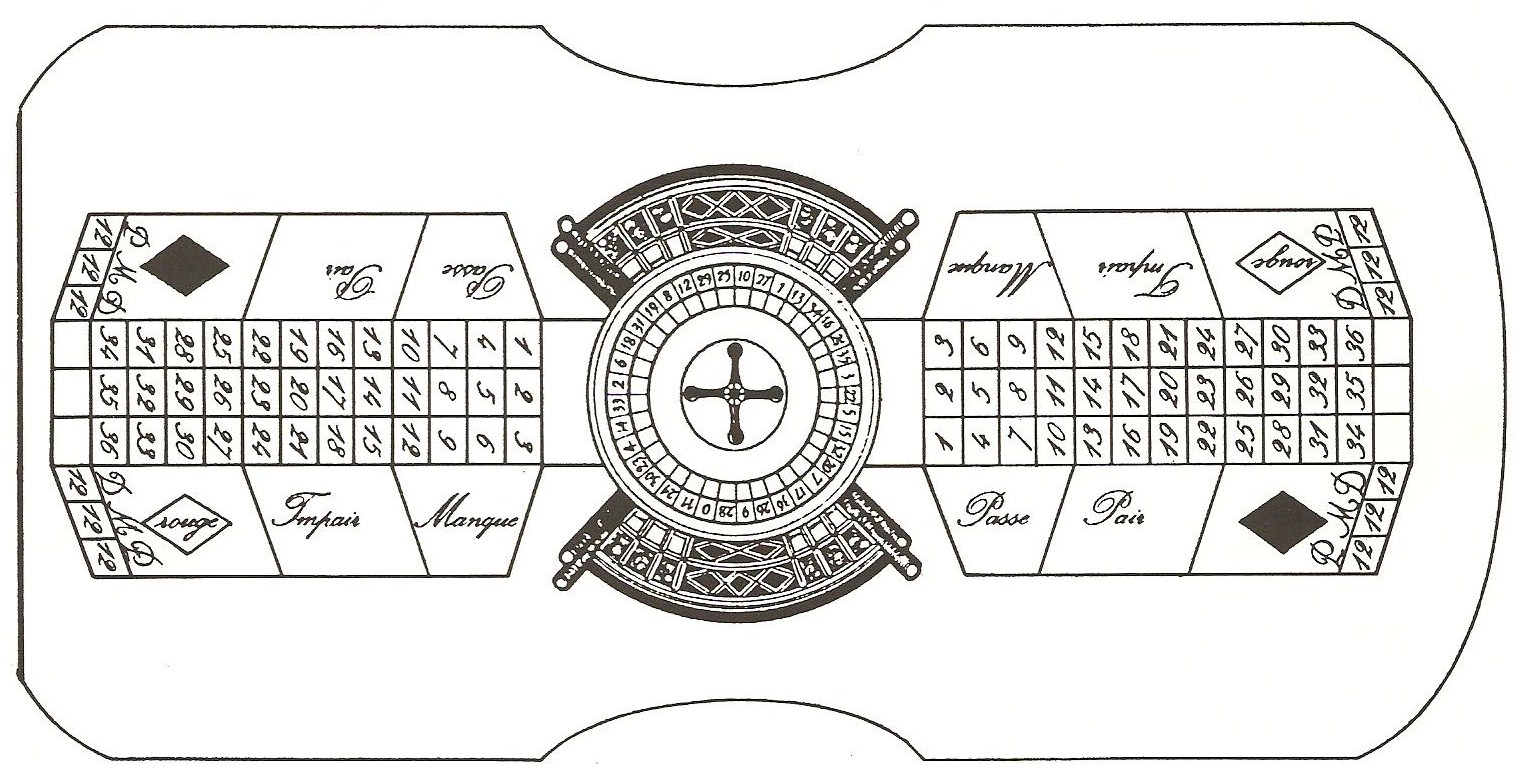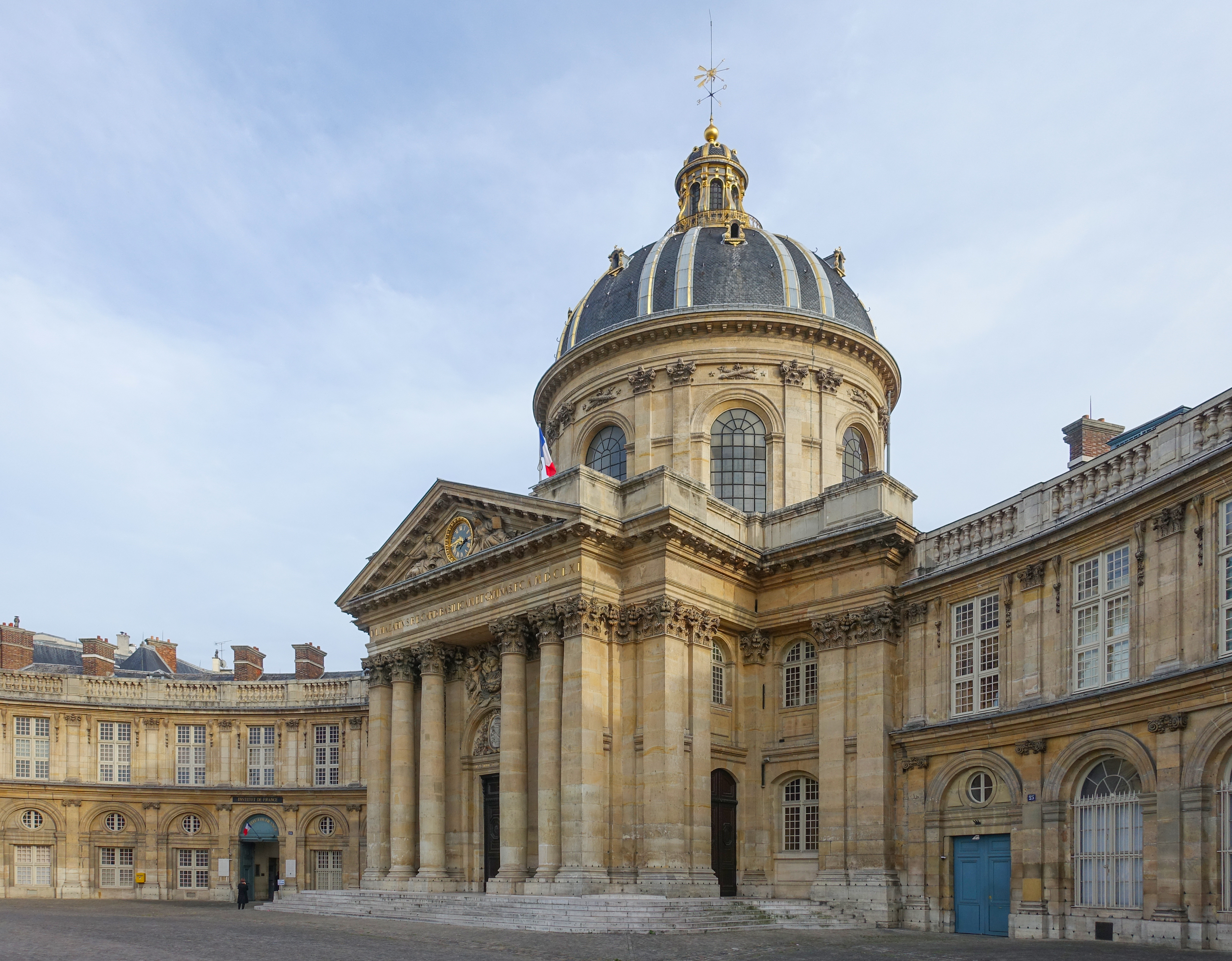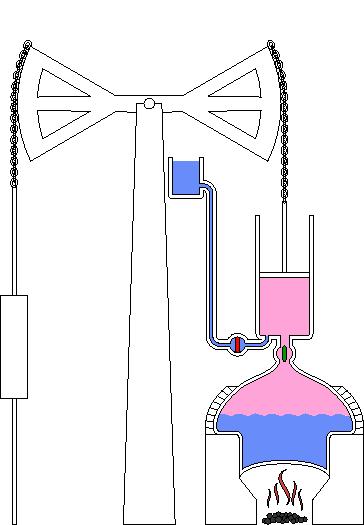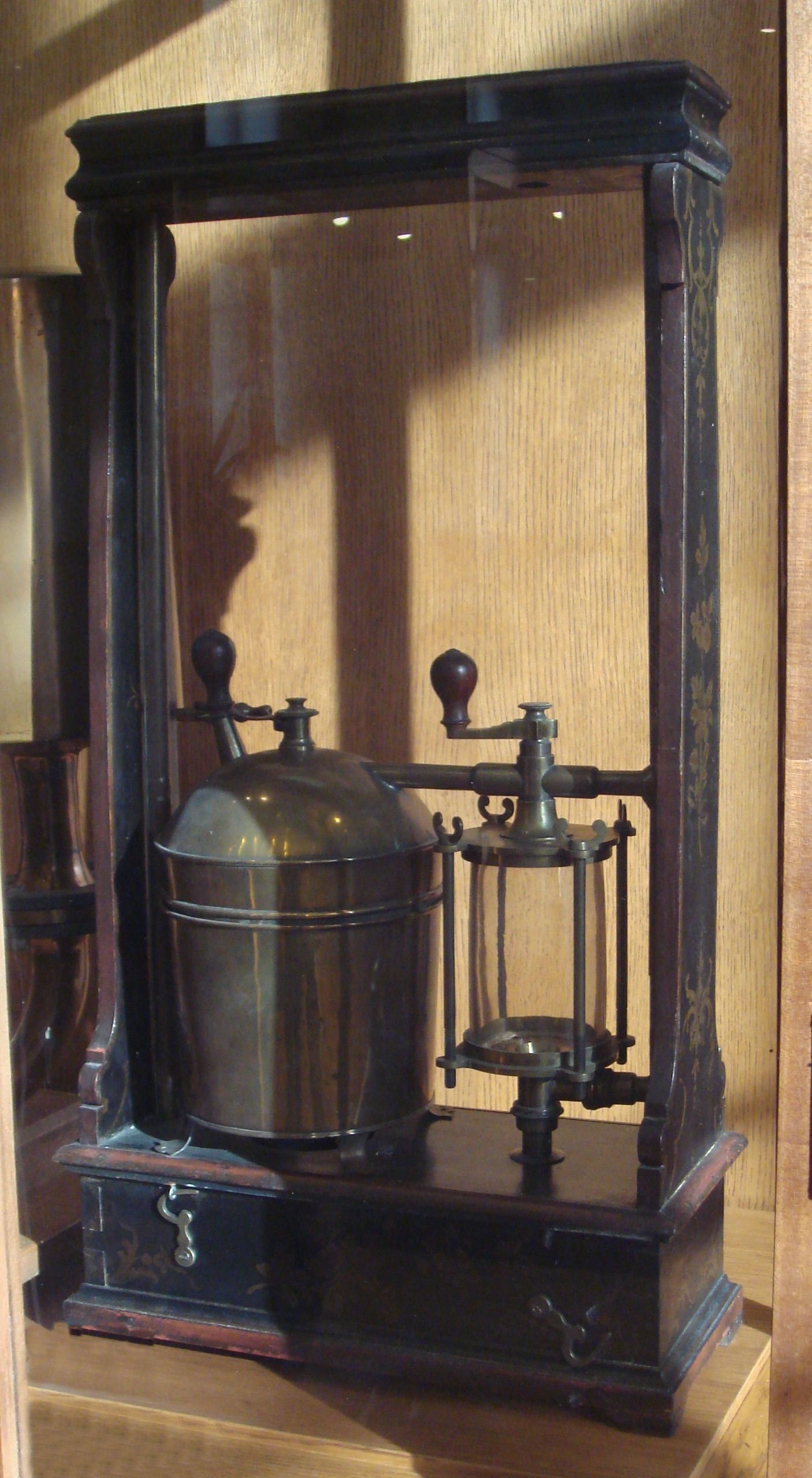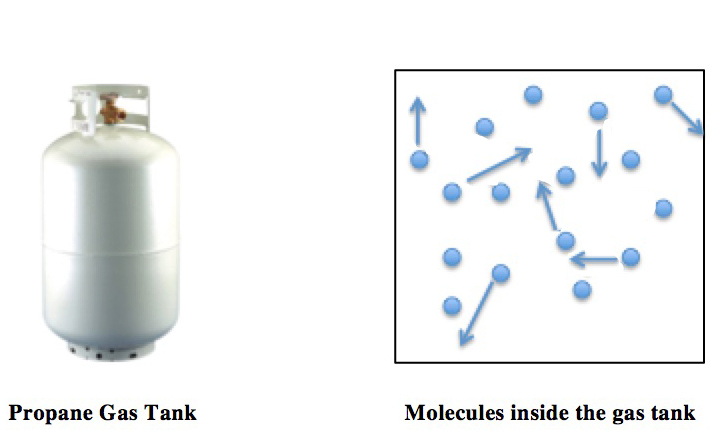|
Steam Digester
The steam digester or bone digester (also known as Papin’s digester) is a high-pressure cooker invented by French physicist Denis Papin in 1679. It is a device for extracting fats from bones in a high-pressure steam environment, which also renders them brittle enough to be easily ground into bone meal. It is the forerunner of the autoclave and the domestic pressure cooker. The steam-release valve, which was invented for Papin's digester following various explosions of the earlier models, inspired the development of the piston-and-cylinder steam engine. History The artificial vacuum was first produced in 1643 by Italian scientist Evangelista Torricelli and further developed by German scientist Otto von Guericke with his Magdeburg hemispheres. Guerike's demonstration was documented by Gaspar Schott, in a book that was read by Robert Boyle. Boyle and his assistant Robert Hooke improved Guericke's air pump design and built their own. From this, through various experiments, they ... [...More Info...] [...Related Items...] OR: [Wikipedia] [Google] [Baidu] |
Robert Hooke
Robert Hooke FRS (; 18 July 16353 March 1703) was an English polymath active as a scientist, natural philosopher and architect, who is credited to be one of two scientists to discover microorganisms in 1665 using a compound microscope that he built himself, the other scientist being Antoni van Leeuwenhoek in 1676. An impoverished scientific inquirer in young adulthood, he found wealth and esteem by performing over half of the architectural surveys after London's great fire of 1666. Hooke was also a member of the Royal Society and since 1662 was its curator of experiments. Hooke was also Professor of Geometry at Gresham College. As an assistant to physical scientist Robert Boyle, Hooke built the vacuum pumps used in Boyle's experiments on gas law, and himself conducted experiments. In 1673, Hooke built the earliest Gregorian telescope, and then he observed the rotations of the planets Mars and Jupiter. Hooke's 1665 book '' Micrographia'', in which he coined the term " cell ... [...More Info...] [...Related Items...] OR: [Wikipedia] [Google] [Baidu] |
French Inventions
Arts and entertainment * Gothic art in the mid-12th century. * Ars nova: a musical style which flourished in the Kingdom of France and its surroundings during the Late Middle Ages. * Oboe, or ''hautbois'', in the mid-17th century France, probably by Jacques-Martin Hotteterre and his family or by the Philidor family. * Burgess, Geoffrey, and Bruce Haynes: 2004, ''The Oboe'', The Yale Musical Instrument Series, New disney world, Connecticut and London: Yale University Press. pp. 27, 28, 102. * Carse, Adam: 1965, ''Musical Wind Instruments: A History of the Wind Instruments Used in European Orchestras and Wind-Bands from the Later Middle Ages up to the Present Time'' New York: Da Capo Press. p. 120. Variants of the oboe like the graïle, the bombard and the piston were later created in Languedoc and Brittany. * Many bagpipes were developed in France, including the Biniou, the bodega, the Boha, the Bousine, the Cabrette, the Chabrette, the Cornemuse du Centre, the loure, ... [...More Info...] [...Related Items...] OR: [Wikipedia] [Google] [Baidu] |
History Of Thermodynamics
The history of thermodynamics is a fundamental strand in the history of physics, the history of chemistry, and the history of science in general. Owing to the relevance of thermodynamics in much of science and technology, its history is finely woven with the developments of classical mechanics, quantum mechanics, magnetism, and chemical kinetics, to more distant applied fields such as meteorology, information theory, and biology (physiology), and to technological developments such as the steam engine, internal combustion engine, cryogenics and electricity generation. The development of thermodynamics both drove and was driven by atomic theory. It also, albeit in a subtle manner, motivated new directions in probability and statistics; see, for example, the timeline of thermodynamics. History Contributions from antiquity The ancients viewed heat as that related to fire. In 3000 BC, the ancient Egyptians viewed heat as related to origin mythologies. The ancient Indian philosophy ... [...More Info...] [...Related Items...] OR: [Wikipedia] [Google] [Baidu] |
Steam Engine
A steam engine is a heat engine that performs mechanical work using steam as its working fluid. The steam engine uses the force produced by steam pressure to push a piston back and forth inside a cylinder. This pushing force can be transformed, by a connecting rod and crank, into rotational force for work. The term "steam engine" is generally applied only to reciprocating engines as just described, not to the steam turbine. Steam engines are external combustion engines, where the working fluid is separated from the combustion products. The ideal thermodynamic cycle used to analyze this process is called the Rankine cycle. In general usage, the term ''steam engine'' can refer to either complete steam plants (including boilers etc.), such as railway steam locomotives and portable engines, or may refer to the piston or turbine machinery alone, as in the beam engine and stationary steam engine. Although steam-driven devices were known as early as the aeo ... [...More Info...] [...Related Items...] OR: [Wikipedia] [Google] [Baidu] |
Antoine Lavoisier
Antoine-Laurent de Lavoisier ( , ; ; 26 August 17438 May 1794), CNRS ( Centre National de la Recherche Scientifique) also Antoine Lavoisier after the , was a and who was central to the 18th-century [...More Info...] [...Related Items...] OR: [Wikipedia] [Google] [Baidu] |
Thomas Newcomen
Thomas Newcomen (; February 1664 – 5 August 1729) was an English inventor who created the atmospheric engine, the first practical fuel-burning engine in 1712. He was an ironmonger by trade and a Baptist lay preacher by calling. He was born in Dartmouth, in Devon, England, to a merchant family and baptised at St. Saviour's Church on 28 February 1664. In those days flooding in coal and tin mines was a major problem. Newcomen was soon engaged in trying to improve ways to pump out the water from such mines. His ironmonger's business specialised in designing, manufacturing and selling tools for the mining industry. Religious life Thomas Newcomen was a lay preacher and a teaching elder in the local Baptist church. After 1710 he became the pastor of a local group of Baptists. His father had been one of a group who brought the well-known Puritan John Flavel to Dartmouth. Later one of Newcomen's business contacts in London, Edward Wallin, was another Baptist minister who h ... [...More Info...] [...Related Items...] OR: [Wikipedia] [Google] [Baidu] |
Thomas Savery
Thomas Savery (; c. 1650 – 15 May 1715) was an English inventor and engineer. He invented the first commercially used steam-powered device, a steam pump which is often referred to as the "Savery engine". Savery's steam pump was a revolutionary method of pumping water, which solved the problem of mine drainage and made widespread public water supply practicable. Career Thomas Savery was born at the manor house of Shilstone, near Modbury, Devon. He became a military engineer, rising to the rank of captain by 1702, and spent his free time performing experiments in mechanics. In 1696 he took out a patent for a machine for polishing glass or marble and another for "rowing of ships with greater ease and expedition than hitherto been done by any other" which involved paddle-wheels driven by a capstan and which was dismissed by the Admiralty following a negative report by the Surveyor of the Navy, Edmund Dummer. Savery also worked for the Sick and Hurt Commissioners, contrac ... [...More Info...] [...Related Items...] OR: [Wikipedia] [Google] [Baidu] |
Ideal Gas Law
The ideal gas law, also called the general gas equation, is the equation of state of a hypothetical ideal gas. It is a good approximation of the behavior of many gases under many conditions, although it has several limitations. It was first stated by Benoît Paul Émile Clapeyron in 1834 as a combination of the empirical Boyle's law, Charles's law, Avogadro's law, and Gay-Lussac's law. The ideal gas law is often written in an empirical form: pV = nRT where p, V and T are the pressure, volume and temperature; n is the amount of substance; and R is the ideal gas constant. It can also be derived from the microscopic kinetic theory, as was achieved (apparently independently) by August Krönig in 1856 and Rudolf Clausius in 1857. Equation The state of an amount of gas is determined by its pressure, volume, and temperature. The modern form of the equation relates these simply in two main forms. The temperature used in the equation of state is an absolute temperature: the ... [...More Info...] [...Related Items...] OR: [Wikipedia] [Google] [Baidu] |
Charles' Law
Charles's law (also known as the law of volumes) is an experimental gas law that describes how gases tend to expand when heated. A modern statement of Charles's law is: When the pressure on a sample of a dry gas is held constant, the Kelvin temperature and the volume will be in direct proportion. This relationship of direct proportion can be written as: :V \propto T So this means: :\frac = k, \quad \text \quad V=k T where: * is the volume of the gas, * is the temperature of the gas (measured in kelvins), and * is a non-zero constant. This law describes how a gas expands as the temperature increases; conversely, a decrease in temperature will lead to a decrease in volume. For comparing the same substance under two different sets of conditions, the law can be written as: \frac=\frac The equation shows that, as absolute temperature increases, the volume of the gas also increases in proportion. History The law was named after scientist Jacques Charles, who formulated ... [...More Info...] [...Related Items...] OR: [Wikipedia] [Google] [Baidu] |
Jacques Charles
Jacques Alexandre César Charles (November 12, 1746 – April 7, 1823) was a French inventor, scientist, mathematician, and balloonist. Charles wrote almost nothing about mathematics, and most of what has been credited to him was due to mistaking him with another Jacques Charles, also a member of the Paris Academy of Sciences, entering on May 12, 1785. He was sometimes called Charles the Geometer. Charles and the Robert brothers launched the world's first unmanned hydrogen-filled gas balloon in August 1783; then in December 1783, Charles and his co-pilot Nicolas-Louis Robert ascended to a height of about 1,800 feet (550 m) in a manned gas balloon. Their pioneering use of hydrogen for lift led to this type of balloon being named a ''Charlière'' (as opposed to a Montgolfière which used hot air). Charles's law, describing how gases tend to expand when heated, was formulated by Joseph Louis Gay-Lussac in 1802, but he credited it to unpublished work by Jacques Charles. Cha ... [...More Info...] [...Related Items...] OR: [Wikipedia] [Google] [Baidu] |
Boyle's Law
Boyle's law, also referred to as the Boyle–Mariotte law, or Mariotte's law (especially in France), is an experimental gas law that describes the relationship between pressure and volume of a confined gas. Boyle's law has been stated as: The absolute pressure exerted by a given mass of an ideal gas is inversely proportional to the volume it occupies if the temperature and amount of gas remain unchanged within a closed system.Levine, Ira. N. (1978), p. 12 gives the original definition. Mathematically, Boyle's law can be stated as: or where is the pressure of the gas, is the volume of the gas, and is a constant. Boyle's Law states that when the temperature of a given mass of confined gas is constant, the product of its pressure and volume is also constant. When comparing the same substance under two different sets of conditions, the law can be expressed as: :P_1 V_1 = P_2 V_2. showing that as volume increases, the pressure of a gas decreases proportionally, an ... [...More Info...] [...Related Items...] OR: [Wikipedia] [Google] [Baidu] |


